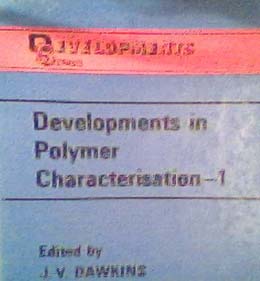 |
Developments in Polymer Characterisation-1 -J.V.Dawkins
PREFACE
Over two decades ago, the term characterisation covered just those techniques which measured the properties of polymers in solution in order to determine molecular weight and size. The discoveries of stereoregular polymers and polymer crystals created the need for new and advanced techniques for characterising chain structures and bulk properties. Further demands for new and improved characterisation methods for bulk polymers have resulted from the recent development and exploitation of multiphase polymeric systems, such as polymer blends, block and graft copolymers, and polymer composites. Today, therefore, characterisation is a very important part of polymer science. The polymer chemist must know the chain length, chain microstructure and chain conformation of the polymers he or she has prepared, i.e. the determination of molecular properties. The scientist involved in exploiting polymers in such applications as plastics, elastomers, fibres, surface coatings and adhesives must be informed on the morphology and physical and mechanical behaviour of his or her products, i.e. the determination of bulk and surface properties and their dependence on molecular properties. The techniques required for these determinations now cover an extremely wide field.
Our aim has been to review a number of ..techniques critically and in sufficient depth so that the present state and future potential of each technique may be judged by the reader. Three criteria were used in the selection of techniques. First, we wished to present new methods which have been developed actively in the polymer field during the past five years. Both 13C nuclear magnetic resonance spectroscopy and small angle neutron scattering, applied to both bulk polymers and polymers in solution, are in this category, and both techniques have provided new and important
characterisation data* which could not be obtained by other methods. Second, we wished to include the significant developments which have occurred recently in using established techniques for polymer characterisation. These are (a) gel permeation chromatography—fast and efficient determinations of molecular weight distribution and average molecular weights; (b) light scattering—Brillouin scattering for transition temperatures of polymeric solids, Rayleigh line broadening for difl'usion coefficients of polymers in solution, and scattering measurements in the region between the binodal and spinodal in polymer solutions; (c) small angle X-ray scattering—characterisation of two-phase polymeric systems; (d) differential scanning calorimetry—quantitative thermodynamic interpretation of the glass transition, heat of fusion and crystallinity; (e) microscopy —range of methods for the surface topography of polymers. Third, we wished to include any technique which although well established has not been widely employed in polymer characterisation. In Chapter 2, the potential of mass spectrometry for studies of the structural characterisation and degradation behaviour of oligomcrs and polymers is described.
It is hoped that the topics presented will appeal not only to specialists but also to those polymer scientists having a general interest in characterisation methods.
|
